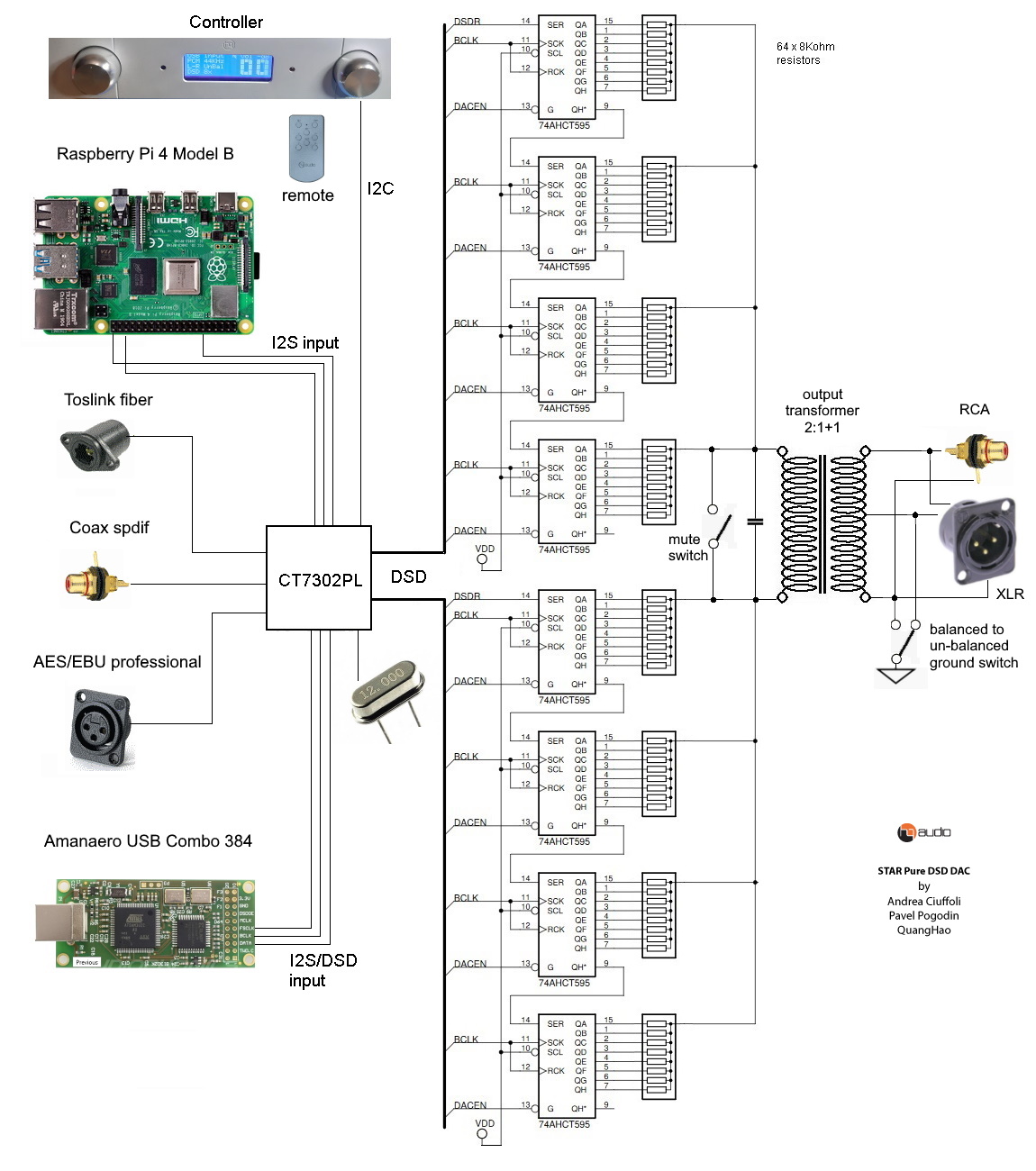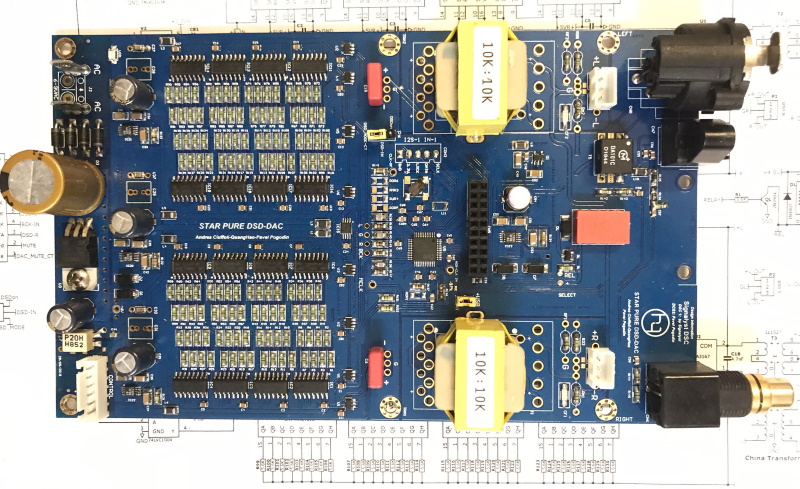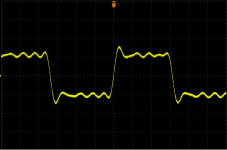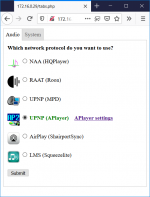... today i have started to take some measurements over the DSC2.
everything seemed perfect.
until i player (trough hqplayer) a 10k square signal.
Not sure if that is supposed to look like that.
the transformer (chinese Black 300+300ohm) is properly loaded to get 6k. Outputs configured for singled ended operation.
everything seemed perfect.
until i player (trough hqplayer) a 10k square signal.
Not sure if that is supposed to look like that.
the transformer (chinese Black 300+300ohm) is properly loaded to get 6k. Outputs configured for singled ended operation.
Attachments
looks fine...
Looks fine. I suppose you are using one of the MP filters in HQP, right? This waveform shows the ringing of the filter used in HQP for oversampling to DSD. This looks like an MP filter response, with the ringing after the impulse.
... today i have started to take some measurements over the DSC2.
everything seemed perfect.
until i player (trough hqplayer) a 10k square signal.
Not sure if that is supposed to look like that.
the transformer (chinese Black 300+300ohm) is properly loaded to get 6k. Outputs configured for singled ended operation.
Looks fine. I suppose you are using one of the MP filters in HQP, right? This waveform shows the ringing of the filter used in HQP for oversampling to DSD. This looks like an MP filter response, with the ringing after the impulse.
Can we see the schematic.
Hi all!
Andrea and me have new design dac with input Ct7302,
Please see some . Thanks
STAR Pure DSD DAC
1 x Star Pure DSD DAC module
1 x Controller LCD module
1 x XLR and RCA output module
1 x Silver remote
This not include Amanero USB module (you can buy directly) and this not include 6.5V 20VA transformer.
INTRODUCTION
The high resolution PCM at 96-192KHz 24bit offer the possibility to have a good quality digital signal exceeding the big limits of the CD.
The DSD is very different from PCM, using a sampling frequency 64 times higher than that of a standard Compact Disc, offers a frequency response of up to 100 kHz and a dynamic range of up to 120 dB across the entire audible range.
The DSD on paper should be better than hi-resolution pcm like the 192KHz 24bit because the two conversions (from and to the analog) are more simple (see this article from Korg website) but the AES Convention Paper 6086 and AES Convention Paper 5395, seems to contradict this.
The DSD signal can be directly used to reconstruct the original analog signal with a simple RC filter but with this method we get many digital noise also using a good digital and analog filters so forget this method.
I have lost many time and money to test these solution, using different USB to DSD interfaces, I2S isolators and D-type flip-flop.
The little Lampizator and RT audiodesign companies has succeeded to reduce the noise and produce a DSD DAC with this method but with some limits.
This project here exposed has another approach, it is based on the DSC1 that is an Open Hardware, "discrete" delta-sigma D/A-converter developped by Signalyst, the DSC1 is able to convert the DSD signal to analog without noise and without a DAC chip.
The DSC converters does not work with a PCM signal so it is necesary convert the PCM to DSD on the fly during playing so it is necessary to use computers with adequate performance.
In this project we have used the CT7302PL single chip dual channel audio digital to digital bridge with a sample rate converter to convert PCM signals to DSD.

HARDWARE
The core of this design is the CT7302PL with the following specifications:
SPDIF support up to 768 KHz/32bits mode
I2S support up to 768 KHz/32bits mode
DSD support 1x/2x/4x/8xmode
DoP support 1x/2x/4x mode,throughI2S
DoP support 1x/2x/4xmode, through SPDIF
PCM SRC / ASRC fully support 32 KHz~ 768 KHz.
PCM / DSD / DoP to PCM / DSD / DoP converter with SRC / ASRC
Crystal reference clock / MCLK / DoP / Mute status output
Auto De-emphasis32KHz/44.1KHz/48KHz.
Auto detecting PCM / DoPformat.
Auto detecting I2S / DSD interface.
Volume control with fading in/out.(+18dB ~ -110dB step 1/32 dB)
SRC / ASRC 32 bits dynamicrange(192dB), THD+N (-174dB).
After the CT7302PL chip there is the DSC in the differential version designed by Pavel Pogodin with the output transformers to filter and to convert the output in un-balanced and balanced signal.
The 74AHCT595 are high-speed Si-gate CMOS devices used for the serial-to-parallel data conversion.
This module use a mute circuit to eliminate any click in the transition from one track to another using the TS5A3167 (SPDT) single-pole double-throw analogswitch .
This module need a AC power supply in the range 6.5V - 7V and it can power the Amanero USB module with a dedicated 3.3V.
On Amanero module to exclude the USB power supply and use an external 3.3V is necessary cut a wire or remove on-board regulator.
The USB interface used is the Amanero with the normal firmware to support Native DSD.


The Controller module included in the kit use the 16F877 chip, a 20MHz Enhanced 8K Flash Microcontrollers.
It drive a 4 x20 characters LCD and it is connected with the I2C bus to the CT7302PL.
A separeted power transformer is used to manage the standby function.

OUTPUT TRANSFORMERS
The output transformers are necessary to mix the differential signals coming from the 74AHCT595 in phase and out phase.
These are also used to give un-balanced and balanced output signal, the module integrate a relay to switch the ground connection.
The models has been selected by Pavel Pogodin after many test and also I have compared these with other models with much higher cost always preferring these.
These have a turn ratio of 2:1+1, made with a permalloy core with a thickness of 0.16mm and an inductance about 340H.
The declared frequency response is 10Hz - 195 KHz at -0.2dB for the yellow and 20Hz - 80 KHz at -0.2dB for the black type
Yellow type has more "air" and black are probably more balanced but it all depends very much on the record or even his mood.
Taobao
AliExpress
Alixpress type 2
REMOTE

SOFTWARE
This hardware is compatible with any PCM and DSD signal so to play music you can use any audio player.
Here follows some player in order of sound performances.
HQPlayer by Signalyst available for Windows, Mac OS and Linux, there is a Server and a Desktop version at a cost of 145,18 euro
Daphile Audiophile Music Server for x86 hardware, it is free but it need a dedicated hardware
JRiver Media Center available for Windows and Mac OS at a cost of $49.98
Foobar2000 freeware
In same case it is necessary increase the output level so use in the setting menu the V+ and -V buttons to set +6dB. +12dB or +18dB, I suggest a max of +6dB because otherwise the distortion can increase.
There is also a function to set an amplification of +6dB for DSD tracks because some player give a lower level for these.
All the settings can be saved in the EEPROM so these will be set at the next power on (press mute button on Setting menu).
MEASUREMENTS
Output at 0dB near to 1.5Vrms.

REVIEWS
STAR DSC took first place in the contest organized by the forum Vnav

Here is the result of a test in October 2019 with a friend of mine with a lot of experience in recording and playing audio.
Yesterday evening the first serious listening test about the new dsc module with CT7302 vs NAA (Network Audio Adapter) DSC module.
The quality of the last DSC with CT7302 is very high, the same details and the same sound stage of the NAA DSC module.
The NAA DSC module with the HQplayer filters is a little bit more softer but it is not easy define if it is more or less near to the real sound.
Using the CT7302 with jRiver the sound is very natural and analog.
PHOTOS



It would be nice to have the specs of the oitput before the transformer... Soekris DAC has 1.3 Vrms and 625 ohm impedance for comparison... on the Soekris i tried ll7903 and ll1674... none of them satisfy me compared to attaching the output directly to the grids of my tube stage. They both veiled and costed clarity / microdynamics... i will compare them to the chinese one suggested here next.
Functionality extension (beta) in micro audiorender for BeagleBone:
http://puredsd.ru/buildroot/sd_botic7_V2.img.gz
ssh root/root
- New audio renders of the LMS and AirPlay protocols have been added. (no DSD support)
- Added support for wpa WFi.
http://puredsd.ru/buildroot/sd_botic7_V2.img.gz
ssh root/root
Attachments
Last edited:
Hello quanghao;
DSC is under CERN Open Hardware Licence;
So if modifications are made and distributed, it must be under the same licence conditions – this is the ‘persistent’ nature of the licence, which ensures that the whole community will continue benefiting from improvements. So please can you share the schematics so we can see what changes you made.
DSC is under CERN Open Hardware Licence;
So if modifications are made and distributed, it must be under the same licence conditions – this is the ‘persistent’ nature of the licence, which ensures that the whole community will continue benefiting from improvements. So please can you share the schematics so we can see what changes you made.
Hi,Hi all
First my DSC2 is now the best I have heard after I changed my PS to LifePo4 batteri supply for the board and also for the amanero USB interface. Beware the DSC2 is a power hungry beast
Next.
Can we use this instead of the amanero?:
DIYINHK XMOS Multichannel 32ch USB to/from I2S/DSD SPDIF Interface | Dimdim's Blog
I really want a multichannel solution (at least 4 channel) so I can use audiolense to do the x-over filter for my line arrays to the subs I am planning...
can you specify which particular LiFePO4 batteries you use + do you use 2 * 3.6 V = 7.2 V for each L / R channel or otherwise ?
Mine cheap Chinese DSC DAC sound improved so much that I was left speechless after I put the main power for shift registers with 2 lead batteries 6 V/4 Ah (like in car but smaller) + NiMH batteries for USB and mute relay
Hi all
......
Next.
Can we use this instead of the amanero?:
DIYINHK XMOS Multichannel 32ch USB to/from I2S/DSD SPDIF Interface | Dimdim's Blog
I really want a multichannel solution (at least 4 channel) so I can use audiolense to do the x-over filter for my line arrays to the subs I am planning...
That board, as it is being sold, outs I2S. If you want to out DSD in multichannel you need a "special" firmware and flash it to the Xmos. I have tried and works well, but I believe that minidsp offers a ready DSD multichannel : check it out here MCHStreamer - USB Audio Swiss-Army knife - Multichannel PCM/DSD/PDM/ADAT/TDM/SPDIF interface
Haven't tried the mchstreamer though, so cannot comment more on that.
cheers
That board, as it is being sold, outs I2S. If you want to out DSD in multichannel you need a "special" firmware and flash it to the Xmos. I have tried and works well, but I believe that minidsp offers a ready DSD multichannel : check it out here MCHStreamer - USB Audio Swiss-Army knife - Multichannel PCM/DSD/PDM/ADAT/TDM/SPDIF interface
Haven't tried the mchstreamer though, so cannot comment more on that.
cheers
I was looking to see if there was a firmware upgrade for my card xmos, couldn't find one and diyinhk wasn't any help.
Can you point me to a revision, and hopefully instructions on how to upload it.
Thanks
Randy
I am afraid there is no revision, Randy, I have the firmware source code (Xmos) modded myself to output multichannel DSD. In case you'd be interested, and has the skills/knowledge to do it, you need to solder a header to the diyinhk board in order to transfer the new firmware with the help of a programmer interface. Definitely not difficult, but not a piece of cake either. Let me know if you feel like it.
The alternative is much more attractive. Just buy a MCHStreamer and transfer the firmware via its USB interface. Minidsp has several firmwares for different purposes. With the baggage and experience I have now, that would be my best course of action.
cheers
Pepe
The alternative is much more attractive. Just buy a MCHStreamer and transfer the firmware via its USB interface. Minidsp has several firmwares for different purposes. With the baggage and experience I have now, that would be my best course of action.
cheers
Pepe
I am afraid there is no revision, Randy, I have the firmware source code (Xmos) modded myself to output multichannel DSD. In case you'd be interested, and has the skills/knowledge to do it, you need to solder a header to the diyinhk board in order to transfer the new firmware with the help of a programmer interface. Definitely not difficult, but not a piece of cake either. Let me know if you feel like it.
The alternative is much more attractive. Just buy a MCHStreamer and transfer the firmware via its USB interface. Minidsp has several firmwares for different purposes. With the baggage and experience I have now, that would be my best course of action.
cheers
Pepe
Sorry, I wasn't clear in my request. It doesn't have anything to do with the DSC though, so I'll send a PM as to not derail the thread anymore.
Randy
Apparently there could be a problem with this board and the DSC2, as the MiniDSP board cannot accept external clock in DSD mode, and the DSC2 has onboard clock generation and therefore needs an USB interface that can work in slave mode. Any suggestions to how this can be fixed, so one can use this multi channel USB to DSD interface with the DSC2?That board, as it is being sold, outs I2S. If you want to out DSD in multichannel you need a "special" firmware and flash it to the Xmos. I have tried and works well, but I believe that minidsp offers a ready DSD multichannel : check it out here MCHStreamer - USB Audio Swiss-Army knife - Multichannel PCM/DSD/PDM/ADAT/TDM/SPDIF interface
Haven't tried the mchstreamer though, so cannot comment more on that.
cheers
Apparently there could be a problem with this board and the DSC2, as the MiniDSP board cannot accept external clock in DSD mode, and the DSC2 has onboard clock generation and therefore needs an USB interface that can work in slave mode. Any suggestions to how this can be fixed, so one can use this multi channel USB to DSD interface with the DSC2?
And you are right there, I have tried the diyinhk board with a different dac that can work in slave mode. The DSC2, as you mentioned, works in masted mode and that means the USB interface needs to work in slave mode. I have not modded the Xmos firmware to accept an external master clock, but could be done though. Amanero has a firmware that does precisely that. The previous version of the DSC (the one that has no reclocking and oscillators on board) I believe would work.
... today i have started to take some measurements over the DSC2.
everything seemed perfect.
until i player (trough hqplayer) a 10k square signal.
Not sure if that is supposed to look like that.
the transformer (chinese Black 300+300ohm) is properly loaded to get 6k. Outputs configured for singled ended operation.
I think that You have "ringing". It is not supposed to look like that. The goal is to have as much squared as You can. And this "type", have always sound signature.
.
Try to use RC notc filter at secondary. Use same 10K file signal and if You have 15K and 20K to check...
R value should be as higher as can be C value opposite, lower as can to make output signal right squared. First step is higher Values of R say more than 6K to lower values, C from 33pF-100pF and up to higher values.
* You have some aplication for that in Jensen papaers, about RC notch filter...
.
After that You can Terminate with R and that larger values than 6K and optionally get smaller.
.
Do not "round" edges too much - will cause loss of Sleeve Rate.
Also bear in mind IF the trafo is at very end without buffer, the next Rin of the preamp say, will make lower value load in parallel with load resistor at the secondary... (Also capacitances of cables is factor in that case.)
.
Also check the phase IF You have some sweep software and hardware to generate DSD from I2S or so. (because I think that we dont have any software for DSD out?)
.
(I am using ComTrue board for that)
.
Cheers and happy building
I think that You have "ringing". It is not supposed to look like that. The goal is to have as much squared as You can. And this "type", have always sound signature.
.
Try to use RC notc filter at secondary. Use same 10K file signal and if You have 15K and 20K to check...
R value should be as higher as can be C value opposite, lower as can to make output signal right squared. First step is higher Values of R say more than 6K to lower values, C from 33pF-100pF and up to higher values.
* You have some aplication for that in Jensen papaers, about RC notch filter...
.
After that You can Terminate with R and that larger values than 6K and optionally get smaller.
.
Do not "round" edges too much - will cause loss of Sleeve Rate.
Also bear in mind IF the trafo is at very end without buffer, the next Rin of the preamp say, will make lower value load in parallel with load resistor at the secondary... (Also capacitances of cables is factor in that case.)
.
Also check the phase IF You have some sweep software and hardware to generate DSD from I2S or so. (because I think that we dont have any software for DSD out?)
.
(I am using ComTrue board for that)
.
Cheers and happy building
thanks for the suggestion.
just tried a R+C on the secondary... until i got to 10k and 100n. effects are rather small/pointless.
i have tried adding 100n to the primary side... and things got "better"... far less rining... but 100n is too much... 47n seems good...
but still with or without capacitors/RC networks... on 15k/20k the output seems more a sinusoid rather a square.
i must think that the problem is else where...
or maybe is just my probing tecnique.
no problem
There is not a problem, that is the ringing of the digital filter. Take a look at some of the DAC measurements at stereophile.com, you will see similar ringing on the top of the squarewave. This ringing is not entirely filtered out, and is, perhaps, one reason we can hear differences between different digital filters.
What happens if you send a native DSD 256 recording (cannot be upsampled, make sure it has been recorded at DSD 256 and no DSP has been applied, ever)? I would suspect a much cleaner top to the square in this case.
thanks for the suggestion.
just tried a R+C on the secondary... until i got to 10k and 100n. effects are rather small/pointless.
i have tried adding 100n to the primary side... and things got "better"... far less rining... but 100n is too much... 47n seems good...
but still with or without capacitors/RC networks... on 15k/20k the output seems more a sinusoid rather a square.
i must think that the problem is else where...
or maybe is just my probing tecnique.
There is not a problem, that is the ringing of the digital filter. Take a look at some of the DAC measurements at stereophile.com, you will see similar ringing on the top of the squarewave. This ringing is not entirely filtered out, and is, perhaps, one reason we can hear differences between different digital filters.
What happens if you send a native DSD 256 recording (cannot be upsampled, make sure it has been recorded at DSD 256 and no DSP has been applied, ever)? I would suspect a much cleaner top to the square in this case.
- Home
- Source & Line
- Digital Line Level
- Signalyst DSC1

